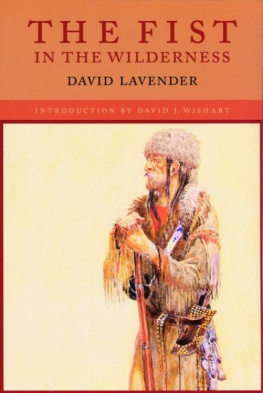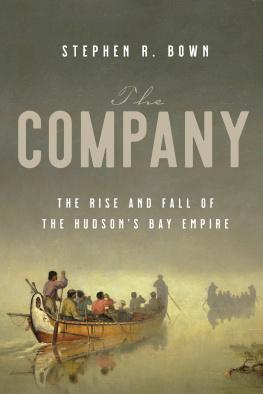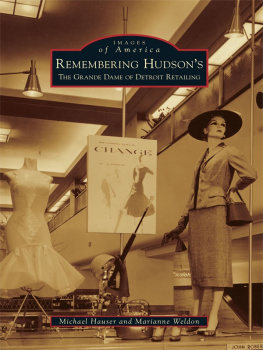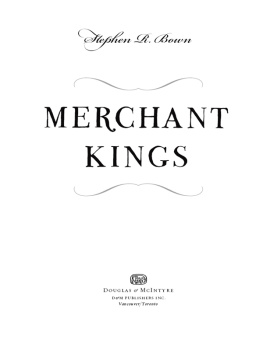HUDSON'S BAY COMPANY ADVENTURES
Tales of Canada's Fur Traders
Elle Andra-Warner

Copyright 2009 Elle Andra-Warner
All rights reserved. No part of this publication may be reproduced, stored in a retrieval system or transmitted in any form or by any meanselectronic, mechanical, audio recording or otherwisewithout the written permission of the publisher or a photocopying licence from Access Copyright, Toronto, Canada.
Published by Heritage House Publishing Co. Ltd. in 2009
in softcover with ISBN 978-1-894974-68-4.
This electronic edition was released in 2011.
e-pub ISBN: 978-1-926613-14-7
e-pdf ISBN: 978-1-926613-49-9
Cataloguing data available from Library and Archives Canada
Edited by Lesley Reynolds
Cover design by Chyla Cardinal
Cover photo courtesy of Glenbow Archives (NA-1041-6)
Heritage House acknowledges the financial support for its publishing program from the Government of Canada through the Canada Book Fund (CBF), Canada Council for the Arts and the province of British Columbia through the British Columbia Arts Council and the Book Publishing Tax Credit.

www.heritagehouse.ca
To Canadas pioneers and First Nations, whose stories continue to inspire us with their spirit of adventure
Prologue
It was a tragic day at Seven Oaks, Manitoba. On June 19, 1816, the Mtis leader, Cuthbert Grant, and his men were armed for war and many wore war paint. As their captain general, Grant was leading over 60 Mtis on horseback to capture the Hudsons Bay Companys Fort Douglas, the centre of Selkirks Red River settlement.
There was no surprise element to the attack. The colonys Governor Semple, a Boston-born Loyalist, had been warned about an attack, but had chosen to ignore the warning. Semple believed diplomacy was all that was needed to defuse the situation. His plan was to meet the attackers and read them the proclamation forbidding Mtis to commit acts of violence against the colony.
When Grant and his mounted riders arrived, the Mtis leader halted his men at the group of trees known as Seven Oaks. They positioned themselves in a half-moon formation. At the same time, Semple led about 30 volunteers, on foot, out of the fort. In single file, they walked across the field to meet the Mtis.
The Mtis began to tighten their half-circle, manoeuvring Semple and his men towards the riverbank. Grant signalled a Mtis named Franois Boucher to order Governor Semple and his men to lay down their armsor be shot. Boucher slowly brought his horse forward. Semple strode forward to meet him and boldly seized the bridle of Bouchers horse. Grant trained his gun on Semple.
A heated discussion developed. What do you want? asked Boucher in broken English. What do you want? said Semple, throwing the question back to Boucher. We want our fort, was the reply. Well, go to your fort! Semple yelled back.
There was a scuffle as Semple tried to seize Bouchers gun. A shot rang out. Grant, who still had his gun on the governorpulled the triggerwounding Semple in the thigh.
And the fierce competition for the fur trade became warfare.
CHAPTER
From the Beaver to the HBC
The story of the North American fur trade started over 500 years ago. It started because of a demand for hats mens fashionable felt hatshats made of beaver pelts.
Back in the sixteenth century, the beavers of Europe and most of Russia had been trapped almost to extinction to satisfy the demand for beaver hats in England. When European hatters, by chance, discovered the superb fur of the beavers in North America, they clamoured to get the fur to make their felt. The richest, most luxuriant beaver pelts came from the cold, far north regions of North America. And the hatters wanted them.
The Native peoples welcomed fur trade with Europeans. They willingly traded their beaver coats and pelts for goods that made their lives easier, such as kettles, knives and guns.
This lucrative market for northern beaver fuelled the fierce rivalry between the English and the French and led to the formation of one of the worlds oldest commercial empiresthe Hudsons Bay Company (HBC).
The Hat That Started It All
The wearing of hats in Europe began in the 1300s, but it would be another 100 years before they became popular. Men were the first to adopt hats as an important fashion item. Mens beaver hats were first made using the actual beaver skins. The felted hats appeared in continental Europe around 1456 and about 50 years later in England. The craze skyrocketed in the 1600s with the introduction of the fine fur of the Canadian beaver. Mens hats were more than a statement of fashion. They were indicators of the wearers social position. The hat symbolized the wearers authority, hierarchy and importance. The bigger the hat, the higher ones status.
The best hats were made from the fur of beaver pelts. They produced a dense, durable, waterproof felt with a lustrous silky sheen. And the European hatters discovered that the very best beaver pelts came from the coat beaver worn by Native peoples in North America. The Native peoples made their coats by sewing six to eight pelts together as a robe, using sinew for thread. They wore the fur side of the pelts next to their body. The sweat of their bodies, mixed with the smoke of their lodges, made the inside fur soft and supple with a silky sheen. The pelts long guard hairs would fall out leaving only the soft underfur. This prized downy fur was used to make the beaver hats.
The first of the popular mens cocked hats were the cavalier hats of the 1600s. Painters presented romantic images of cavaliers in England and musketeers in France wearing these hats. The wide-brimmed beaver hats were trimmed with ostrich plumes and jewellery, and one side of the brim was usually cocked or rolled. Although they were very impressive, the droopy brims were a hazard for horse riding and sword fighting.
As mens hats became more of a status symbol, the cocked beaver hats grew bigger and higher. The classic tricorne hats of the 1700s became popular in the American and French Revolutions, and were worn by gentlemen and courtiers throughout Europe, as well as by pirates. Around 1790, the bicorne hat also became the fashion choice for artists and intellectuals. In addition, it was the military dress hat of the British, the Americans and the French. The bicorne hat was the signature hat of Napoleon Bonaparte.
For over 200 years, making hats with beaver felt was a flourishing industry. Good hatters made roughly nine hats a week. Five different groups of workers carried out 36 separate steps to produce one beaver hat. Tasks were arranged by gender. Women were responsible for preparing the fibres and doing the finishing work. Men were responsible for bowing the fur into batts, felting and fulling the batts into hats, and blocking, shaving, dyeing, stiffening and waterproofing them. The finest quality beaver hats had 9 to 12 ounces of pure fur in them. It took four beaver pelts to produce one pound of the fine, soft underfur.
The world of hat making was full of secret formulas and rivalries. Hat shops developed exclusive processes and mixtures. If an employee revealed these trade secrets to a competitors shop, the punishment could be death.
And there was always the danger of the mad hatter syndromeheavy metal poisoning from mercury. The pelts were soaked in a solution of mercury (mercuric oxide) to make the fur come off the pelts easily (called carroting because it gave fibres an orange tint). The mercury in the steam coming off the felt attacked the central nervous system of those involved in the felting and fulling of the hats. Hence the term mad as a hatter.









